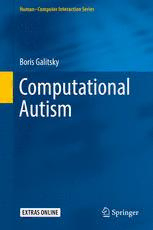
Computational Autism PDF
Preview Computational Autism
Human–Computer Interaction Series Boris Galitsky Computational Autism Human–Computer Interaction Series Editors-in-chief DesneyTan,MicrosoftResearch,USA JeanVanderdonckt,UniversitécatholiquedeLouvain,Belgium HCI is a multidisciplinary field focused on human aspects of the development of computer technology. As computer-based technology becomes increasingly pervasive – not just in developed countries, but worldwide – the need to take a human-centered approach in the design and development of this technology becomes ever more important. For roughly 30 years now, researchers and practitioners in computational and behavioral sciences have worked to identify theory and practice that influences the direction of these technologies, and this diverseworkmakesupthefieldofhuman-computerinteraction.Broadlyspeaking it includes the study of what technology might be able to do for people and how people might interact with the technology. The HCI series publishes books that advancethescienceandtechnologyofdevelopingsystemswhicharebotheffective and satisfying for people in a wide variety of contexts. Titles focus on theoretical perspectives (such as formal approaches drawn from a variety of behavioral sciences), practical approaches (such as the techniques for effectively integrating user needs in system development), and social issues (such as the determinants of utility,usabilityandacceptability). TitlespublishedwithintheHuman–ComputerInteractionSeriesareincludedin ThomsonReuters’BookCitationIndex,TheDBLPComputerScienceBibliography andTheHCIBibliography. Moreinformationaboutthisseriesathttp://www.springer.com/series/6033 Boris Galitsky Computational Autism 123 BorisGalitsky Knowledge-TrailInc. SanJose,CA,USA Additionalmaterialtothisbookcanbedownloadedfromhttp://extras.springer.com. ISSN1571-5035 Human–ComputerInteractionSeries ISBN978-3-319-39971-3 ISBN978-3-319-39972-0 (eBook) DOI10.1007/978-3-319-39972-0 LibraryofCongressControlNumber:2016943550 ©SpringerInternationalPublishingSwitzerland2016 Thisworkissubjecttocopyright.AllrightsarereservedbythePublisher,whetherthewholeorpartof thematerialisconcerned,specificallytherightsoftranslation,reprinting,reuseofillustrations,recitation, broadcasting,reproductiononmicrofilmsorinanyotherphysicalway,andtransmissionorinformation storageandretrieval,electronicadaptation,computersoftware,orbysimilarordissimilarmethodology nowknownorhereafterdeveloped. Theuseofgeneraldescriptivenames,registerednames,trademarks,servicemarks,etc.inthispublication doesnotimply,evenintheabsenceofaspecificstatement,thatsuchnamesareexemptfromtherelevant protectivelawsandregulationsandthereforefreeforgeneraluse. Thepublisher,theauthorsandtheeditorsaresafetoassumethattheadviceandinformationinthisbook arebelievedtobetrueandaccurateatthedateofpublication.Neitherthepublishernortheauthorsor theeditorsgiveawarranty,expressorimplied,withrespecttothematerialcontainedhereinorforany errorsoromissionsthatmayhavebeenmade. Printedonacid-freepaper ThisSpringerimprintispublishedbySpringerNature TheregisteredcompanyisSpringerInternationalPublishingAGSwitzerland Toteachachildwithautism,onemightfirst considerlearninghowtoprogramarobot Contents 1 Introduction:PhenomenaofAutisticReasoning........................ 1 1.1 HowComputerScientistsCanHelpIndividualswithAutism..... 4 1.2 DevelopingDeductiveReasoningSkillsofMachines andChildrenwithAutism ........................................... 5 1.3 PriorWorkinIntelligentSystemsforAutisticEducation.......... 7 1.4 TeachingTheoryofMindtoAutisticPatients...................... 9 1.5 HowtoReadThisBook ............................................. 12 References.................................................................... 13 2 ComputationalModelsofAutism......................................... 17 2.1 AutisticDeficits ...................................................... 17 2.1.1 HypothesesfortheOriginofAutisticReasoning......... 24 2.2 Tests for Differentiating Normal and Autistic CognitionandReasoning ............................................ 24 2.3 NeuralNetworkModels ............................................. 27 2.3.1 TheBridgeBetweenNeuralModelsandReasoning ..... 28 2.3.2 SensoryHyper-sensitivity.................................. 30 2.3.3 HighorLowConnectivity? ................................ 32 2.3.4 DeviationofNeuralNetworkFunctioning................ 33 2.3.5 NeuralNetworkArchitecture .............................. 36 2.3.6 NeuralSimulationofAttentionDeficitDisorder.......... 37 2.4 Game-TheoreticApproach........................................... 39 2.5 AccountsofAutism.................................................. 40 2.5.1 WeakCentralCoherenceAccount......................... 41 2.5.2 ExecutiveFunctionDeficitAccount....................... 44 2.5.3 AutisticMemory............................................ 47 2.5.4 AccountofComplexInformationProcessingFailure .... 49 2.5.5 AffectiveFoundationAccount............................. 51 2.5.6 ThinkinginPicturesAccountofAutism.................. 53 2.5.7 JointAttentionFamilyofAccounts ....................... 56 2.5.8 FromIntenttoSymbolicRepresentation.................. 57 vii viii Contents 2.5.9 StepsintheNormalDevelopment......................... 60 2.5.10 AccountsofAutismandCorporateEnvironment......... 62 2.6 AutisticLinguistics................................................... 63 2.6.1 Cognitive Skills and Processes Involved inMakingSenseofText.................................... 63 2.6.2 GrammarandAffect........................................ 67 2.6.3 UnderstandingMetaphors.................................. 68 2.7 OurAccountofAutism:ReasoningEngine➔Behavior .......... 70 2.8 DiscussionandConclusions......................................... 72 References.................................................................... 73 3 IntuitiveTheoryofMind .................................................. 79 3.1 IntroducingTheoryofMind......................................... 79 3.2 EmphasizingandSystemizing....................................... 82 3.3 ToMandOtherAutisticAccounts................................... 85 3.4 ToMandaModuletoImplementIt ................................. 86 3.5 ToMinHumansandAnimals ....................................... 87 3.6 CwAandCCinAbstractReasoningTasks ......................... 88 3.7 ToMControversy..................................................... 89 3.8 DiscussionandConclusions......................................... 90 References.................................................................... 91 4 FormalizingTheoryofMind.............................................. 95 4.1 ComputerScienceofTheoryofMind............................... 96 4.1.1 DefiningMainProblemofToM ........................... 96 4.1.2 Belief–Desire–IntentionModel............................ 99 4.1.3 Meta-Reasoning ............................................ 101 4.1.4 EntitiesofToM ............................................. 106 4.1.5 LinguisticsofToMEntities ................................ 107 4.1.6 FromDeductiontoSimulationandLearning ............. 109 4.2 ToMStep-by-Step.................................................... 113 4.2.1 MentalStatesandActions.................................. 114 4.2.2 ExampleofaDefinitionofaMentalAction .............. 117 4.2.3 DerivedMetapredicates .................................... 119 4.2.4 HandlingMultipleMeanings .............................. 120 4.2.5 RepresentingEmotions..................................... 122 4.3 ScenariosintheMentalWorld....................................... 126 4.3.1 MultiagentConflict......................................... 128 4.3.2 DimensionsofIntentionality............................... 128 4.3.3 DissatisfactionandComplaintScenarios.................. 130 4.3.4 RecognizingPlausibleScenarios .......................... 135 4.3.5 Communicative Actions and Similarity BetweenThem.............................................. 136 4.3.6 DefiningScenarioasGraphs............................... 145 4.3.7 MachineLearningofConflictScenarios .................. 151 Contents ix 4.3.8 LinkedSub-Scenarios...................................... 154 4.3.9 ScenarioasaSequenceofLocalLogics................... 156 4.4 SomeApplicationsofFormalizedToM............................. 158 4.4.1 LearningConflictsBetweenCommunitiesofAgents .... 158 4.4.2 EmotionalProfile........................................... 159 4.4.3 Analyzing an Email from a Would-Be TerroristAttacker........................................... 162 4.4.4 ReasoningwithEmotionalProfiles........................ 163 4.4.5 EvaluationofAdequatenessofRepresentation ........... 167 4.4.6 VisualRepresentation ...................................... 170 4.5 DiscussionsandConclusion......................................... 170 References.................................................................... 173 5 TheoryofMindEngine .................................................... 177 5.1 TheTaskofNL_MAMS............................................. 177 5.2 SimulatingReasoningAboutMentalStates ........................ 179 5.3 ImplementationofSimulation....................................... 182 5.3.1 Choosing the Best Action Considering YourselfOnly............................................... 182 5.3.2 Choosing the Best Action Taking into AccountActionSelectionAnalysisofOthers............. 184 5.3.3 TheLibraryofAvailableBehaviors ....................... 186 5.4 EvaluationofNL_MAMS ........................................... 189 5.4.1 EvaluationofCorrectness.................................. 192 5.4.2 EvaluationofCoverage..................................... 193 5.4.3 EvaluationofComplexity.................................. 195 5.5 AccompanyingReasoningSystemsandApplicationDomains.... 196 5.6 HCIIssuesofAutisticTraining...................................... 197 5.7 OtherToM-RelatedSystems......................................... 201 5.7.1 CommonsensePsychologySystem........................ 207 5.7.2 ASymbolicProduction-BasedSystem.................... 209 5.8 DiscussionandConclusions......................................... 210 References.................................................................... 211 6 ReasoningBeyondtheMentalWorld .................................... 215 6.1 MentalvsPhysicalWorld............................................ 215 6.1.1 AutisticGeneralization..................................... 217 6.2 Reasoning,CognitiveScienceandRationality ..................... 218 6.3 AutisticProbabilisticandCounterfactualReasoning............... 221 6.3.1 ExampleReliefStoryandQuestions ...................... 223 6.3.2 ExampleRegretStoryandQuestions...................... 223 6.4 AutisticPlanningandAdjustmentofActiontoaNew Environment.......................................................... 224 6.4.1 TriangulationStructure..................................... 224 6.4.2 TriangulationCases......................................... 225 x Contents 6.4.3 Discovering Commonalities Between theTriangulationCases .................................... 230 6.4.4 BuildingaBridgeBetweenTriangulation andDefaultReasoning ..................................... 231 6.4.5 HandlingaSingleDefaultRulebyAutisticReasoning .. 233 6.4.6 HandlingConflictingDefaultRules ....................... 237 6.5 DiscussionandConclusions......................................... 241 References.................................................................... 243 7 AutisticLearningandCognition............................................ 245 7.1 AutisticCognition.................................................... 245 7.2 ActiveLearninginComputerScience .............................. 248 7.2.1 PerformanceofanActiveLearningSystems.............. 250 7.2.2 Monitoring, Assessing and Terminating theLearningProcess ....................................... 250 7.3 ActiveLearningandAutisticDevelopment......................... 251 7.3.1 Hyper-sensitivity............................................ 251 7.3.2 AutisticAdaptation......................................... 253 7.3.3 ActiveInductiveLearningofCwAandCC............... 253 7.3.4 LearningRepetitivePatterns............................... 255 7.3.5 Stereotypy................................................... 257 7.3.6 IgnoringImportantFeatures ............................... 263 7.3.7 From Hyper-sensitivity to Stereotypy ofanEngineeringSystem.................................. 265 7.4 HybridActiveLearningSystemJasmine ........................... 266 7.4.1 AReasoningSchema....................................... 269 7.4.2 ComputingSimilarityBetweenObjects................... 274 7.4.3 NormalandAutisticDevelopmentPathways forJasmine.................................................. 277 7.5 Exploring Forming and Updating Hypotheses inHumanLearning................................................... 281 7.6 DeductiveReasoningAboutActions................................ 284 7.6.1 TheArchitectureofaHybridSystem...................... 288 7.6.2 MergingDeductiveandInductiveReasoning AboutAction................................................ 289 7.7 DiscussionandConclusions......................................... 291 References.................................................................... 292 8 RehabilitatingAutisticReasoning ........................................ 295 8.1 TrainingEnvironment................................................ 295 8.1.1 Short-TermandLong-TermTrainingSettings ............ 297 8.2 ExercisingScenarios................................................. 299 8.2.1 MentalStateofAnotherPerson............................ 299 8.2.2 AWrongMentalState...................................... 301 8.2.3 MentalStateTransmission................................. 301 8.2.4 Temporal Relationships Over the Mental States.ToForgetandtoRecall............................. 302
